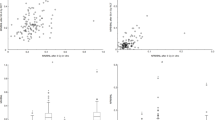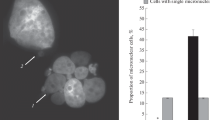Abstract
Purpose:
The goal of the interdisciplinary Clinical Research Unit KFO179 (Biological Basis of Individual Tumor Response in Patients with Rectal Cancer) is to develop an individual Response and Toxicity Score for patients with locally advanced rectal cancer treated with neoadjuvant radiochemotherapy. The aim of the present study was to find a reliable and sensitive method with easy scoring criteria and high numbers of cell counts in a short period of time in order to analyze DNA damage in peripheral blood lymphocytes. Thus, the cytokinesis-block micronucleus (CBMN) assay and the chromosome aberration technique (CAT) were tested.
Materials and Methods:
Peripheral blood lymphocytes obtained from 22 patients with rectal cancer before (0 Gy), during (21.6 Gy), and after (50.4 Gy) radiochemotherapy were stimulated in vitro by phytohemagglutinin (PHA); the cultures were then processed for the CBMN assay and the CAT to compare the two methods.
Results:
A significant increase of chromosomal damage was observed in the course of radiochemotherapy parallel to increasing radiation doses, but independent of the chemotherapy applied. The equivalence of both methods was shown by Westlake’s equivalence test.
Conclusion:
The results show that the CBMN assay and the CAT are equivalent. For further investigations, we prefer the CBMN assay, because it is simpler through easy scoring criteria, allows high numbers of cell counts in less time, is reliable, sensitive, and has higher statistical power. In the future, we plan to integrate cytogenetic damage during radiochemotherapy into the planned Response and Toxicity Score within our interdisciplinary Clinical Research Unit.
Zusammenfassung
Ziel:
Ziel der interdisziplinären Klinischen Forschergruppe KFO179 (Biological Basis of Individual Tumor Response in Patients with Rectal Cancer) ist es, einen individuellen Response-/Toxizitätsscore für Patienten zu entwickeln, die bei diagnostiziertem lokal fortgeschrittenem Rektumkarzinom mit neoadjuvanter Radiochemotherapie behandelt werden. Ziel der vorliegenden Arbeit war, eine einfache und zuverlässige Methode zur Detektion des individuellen zytogenetischen Schadens durch die Radiochemotherapie herauszuarbeiten, die im weiteren Verlauf der Arbeit der Forschergruppe Anwendung finden soll. Wir verglichen dabei den Mikronukleustest (MN) mit der Chromosomenaberrationsanalyse (CAA).
Patienten und Methodik:
Periphere Blutlymphozyten von 22 Patienten wurden vor (0 Gy), während (21,6 Gy) und nach (50,4 Gy) Radiochemotherapie untersucht. Der zytogenetische Schaden wurde mittels MN und CAA analysiert und die Äquivalenz beider Methoden geprüft.
Ergebnisse:
Eine signifikante Zunahme chromosomaler Schädigungen durch die Bestrahlung in Abhängigkeit von der applizierten Dosis konnte bei beiden Techniken, unabhängig von der applizierten Chemotherapie, beobachtet werden. Die Gleichwertigkeit beider Methoden konnte durch den Äquivalenztest nach Westlake gezeigt werden.
Schlussfolgerung:
Es zeigte sich eine Äquivalenz der angewandten Methoden, was uns nun die Möglichkeit bietet, den MN gleichwertig gegenüber der CAA anzuwenden und für die geplanten Analysen bezüglich des individuellen Response-/Toxizitätsscores zu verwenden. Die Mikronukleustechnik ermöglicht durch leichtere Zählkriterien in kürzerer Zeit eine größere Anzahl von Zellen zu zählen, was zu einem valideren statistischen Endergebnis führt.
Similar content being viewed by others
References
Almeida GM, Duarte TL, Steward WP, et al. Detection of oxaliplatin-induced DNA crosslinks in vitro and in cancer patients using the alkaline comet assay. DNA Repair (Amst) 2006;5:219–25.
Antoine JL, Gerber GB, Leonard A, et al. Chromosome aberrations induced in patients treated with telecobalt therapy for mammary carcinoma. Radiation Research 1981;86:171–7.
Bahl A, Chander S, Julka PK, et al. Micronuclei evaluation of reduction in neoadjuvant chemotherapy related acute toxicity in locally advanced lung cancer: an indian experience. J Assoc Physicians India 2006;54:191–5.
Bilban-Jakopin C, Bilban M. Genotoxic effects of radiotherapy and chemotherapy on circulating lymphocytes in patients with Hodgkin’s disease. Mutat Res 2001;497:81–8.
Brunner E., Domhof S, Langer F. Nonparametric analysis of longitudinal data in factorial experiments. New York: Wiley 2002:187–210.
Catena C, Conti D, Parasacchi P et al. Micronuclei in cytokinesis-blocked lymphocytes may predict patient response to radiotherapy. Int J Radiat Biol 1996;70:301–8.
Das B, Karuppasamy CV. Spontaneous frequency of micronuclei among the newborns from high level natural radiation areas of Kerala in the southwest coast of India. Int J Radiat Biol 2009;85:272–80.
Diener A, Stephan G, Vogl T, et al. The induction of chromosome aberrations during the course of radiation therapy for morbus Hodgkin. Radiat Res 1988;114:528–36.
Fenech M. Cytokinesis-block micronucleus cytome assay. Nat Protoc 2007;2:1084–104.
Fenech M. The in vitro micronucleus technique. Mutat Res 2000;455:81–95.
Fenech M, Denham J, Francis W, et al. Micronuclei in cytokinesis-blocked lymphocytes of cancer patients following fractionated partial-body radiotherapy. Int J Radiat Biol 1990;57:373–83.
Fenech M, Morley A. Solutions to the kinetic problem in the micronucleus assay. Cytobios 1985;43:233–46.
Fenech M, Morley AA. Cytokinesis-block micronucleus method in human lymphocytes: effect of in vivo ageing and low dose X-irradiation. Mutat Res 1986;161:193–8.
Fenech M, Morley AA. Measurement of micronuclei in lymphocytes. Mutat Res 1985;147:29–36.
Fernandes TS, Lloyd D, Amaral A. A comparison of different cytological stains for biological dosimetry. Int J Radiat Biol 2008;84:703–11.
Gamulin M, Kopjar N, Grgic, M et al. Genome damage in oropharyngeal cancer patients treated by radiotherapy. Croat Med J 2008;49:515–27.
Gantenberg HW, Wuttke K, Streffer C, et al. Micronuclei in human lymphocytes irradiated in vitro or in vivo. Radiat Res 1991;128:276–81.
Garaj-Vrhovac V, Fucic A, Horvat D. The correlation between the frequency of micronuclei and specific chromosome aberrations in human lymphocytes exposed to microwave radiation in vitro. Mutat Res 1992;281:181–6.
Hatayoglu SE, Orta T. Relationship between radiation induced dicentric chromosome aberrations and micronucleus formation in human lymphocytes. J Exp Clin Cancer Res 2007;26:229–34.
Hoskins J, Scott Butler J. Evidence for distinct DNA- and RNA-based mechanisms of 5-fluorouracil cytotoxicity in Saccharomyces cerevisiae. Yeast 2007;24:861–70.
Keilholz L, Mese M, Henneking K, et al. Effect of total mesorectal excision on the outcome of rectal cancer after standardized postoperative radiochemotherapy: do randomized studies translate into clinical routine? Strahlenther Onkol 2009;185:364–70.
Kormos C, Koteles GJ. Comparison of cytogenetic tests for monitoring overexposures from ionizing radiation. Acta Biol Hung 1990;41:115–20.
Lee TK, O’Brien KF, Naves JL, et al. Micronuclei in lymphocytes of prostate cancer patients undergoing radiation therapy. Mutat Res 2000;469:63–70.
Marquardt F, Rodel F, Capalbo G, et al. Molecular targeted treatment and radiation therapy for rectal cancer. Strahlenther Onkol 2009;185:371–8.
Mateuca R, Lombaert N, Aka PV, et al. Chromosomal changes: induction, detection methods and applicability in human biomonitoring. Biochimie 2006;88:1515–31.
Matsubara S, Sasaki MS, Adachi T. Dose-response relationship of lymphocyte chromosome aberrations in locally irradiated persons. Journal of Radiation Research (Tokyo) 1974;15:189–96.
Obe G, Matthiessen W, Gobel D. Chromosomal aberrations in the peripheral lymphocytes of cancer patients treated with high-energy electrons and bleomycin. Mutat Res 1981;81:133–41.
Padjas A, Lesisz D, Lankoff A, et al. Cytogenetic damage in lymphocytes of patients undergoing therapy for small cell lung cancer and ovarian carcinoma. Toxicol Appl Pharmacol 2005;209:183–91.
Parker WB, Cheng YC. Metabolism and mechanism of action of 5-fluorouracil. Pharmacol Ther 1990;48:381–95.
Paskeviciute B, Bolling T, Brinkmann M, et al. Impact of (18)F-FDG-PET/CT on staging and irradiation of patients with locally advanced rectal cancer. Strahlenther Onkol 2009;185:260–5.
Pathak R, Sarma A, Sengupta B, et al. Response to high LET radiation 12C (LET, 295 keV/microm) in M5 cells, a radio resistant cell strain derived from Chinese hamster V79 cells. Int J Radiat Biol 2007;83:53–63.
Rigaud O, Guedeney G, Duranton I, et al. Genotoxic effects of radiotherapy and chemotherapy on the circulating lymphocytes of breast cancer patients. I. Chromosome aberrations induced in vivo. Mutat Res 1990;242: 17–23.
Sala-Trepat M, Cole J, Green MH, et al. Genotoxic effects of radiotherapy and chemotherapy on the circulating lymphocytes of breast cancer patients. III: Measurement of mutant frequency to 6-thioguanine resistance. Mutagenesis 1990;5:593–8.
Seoane A, Guerci A, Dulout F. Genetic instability induced by low doses of x-rays in hamster cells. Int J Radiat Biol 2007;83:81–7.
Singh S, Datta NR, Krishnani N, et al. Radiation therapy induced micronuclei in cervical cancer–does it have a predictive value for local disease control? Gynecol Oncol 2005;97:764–71.
Slonina D, Biesaga B, Urbanski K, et al. Comparison of chromosomal radiosensitivity of normal cells with and without HRS-like response and normal tissue reactions in patients with cervix cancer. Int J Radiat Biol 2008;84:421–8.
Stephan G, Schneider K, Panzer W, et al. Enhanced yield of chromosome aberrations after CT examinations in paediatric patients. Int J Radiat Biol 2007;83:281–7.
Thierens H, Vral A, Van Eijkeren M, et al. Micronucleus induction in peripheral blood lymphocytes of patients under radiotherapy treatment for cervical cancer or Hodgkin’s disease. Int J Radiat Biol 1995;67:529–39.
Thomas P, Umegaki K, Fenech M. Nucleoplasmic bridges are a sensitive measure of chromosome rearrangement in the cytokinesis-block micronucleus assay. Mutagenesis 2003;18:187–94.
Vorwerk H, Liersch T, Rothe H, et al. Gold markers for tumor localization and target volume delineation in radiotherapy for rectal cancer. Strahlenther Onkol 2009;185:127–33.
Westlake WJ. Response to T.B.L. Kirkwood: bioequivalence testing—a need to rethink. Biometrics 1981;37:589–94.
Widel M, Jedrus S, Lukaszczyk B, et al. Radiation-induced micronucleus frequency in peripheral blood lymphocytes is correlated with normal tissue damage in patients with cervical carcinoma undergoing radiotherapy. Radiat Res 2003;159:713–21.
Wolff HA, Gaedcke J, Jung K, et al. High-grade acute organ toxicity during preoperative radiochemotherapy as positive predictor for complete histopathologic tumor regression in multimodal treatment of locally advanced rectal cancer. Strahlenther Onkol 2010;186:30–5.
Woynarowski JM, Faivre S, Herzig MC, et al. Oxaliplatin-induced damage of cellular DNA. Mol Pharmacol 2000;58:920–7.
Wuttke K, Müller W-U, Streffer C. The sensitivity of the in vitro cytokinesisblock micronucleus assay in lymphocytes for different and combined radiation qualities. Strahlenther Onkol 1998;174:262–8.
Xuncla M, Barquinero JF, Caballin MR, et al. Cytogenetic damage induced by radiotherapy. Evaluation of protection by amifostine and analysis of chromosome aberrations persistence. Int J Radiat Biol 2008;84:243–51.
Author information
Authors and Affiliations
Corresponding author
Additional information
*H. A. Wolff and S. Hennies contributed equally to this work
Rights and permissions
About this article
Cite this article
Wolff*, H.A., Hennies, S., Herrmann, M.K.A. et al. Comparison of the Micronucleus and Chromosome Aberration Techniques for the Documentationof Cytogenetic Damage in Radiochemotherapy-Treated Patients with Rectal Cancer. Strahlenther Onkol 187, 52–58 (2011). https://doi.org/10.1007/s00066-010-2163-9
Received:
Accepted:
Published:
Issue Date:
DOI: https://doi.org/10.1007/s00066-010-2163-9




